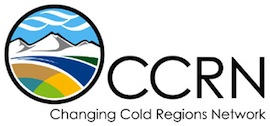
Dr. Sean Carey
School Of Geography & Earth Sciences, McMaster University
 (905) 525-9140 ext. 20134
(905) 525-9140 ext. 20134 careysk@mcmaster.ca
careysk@mcmaster.ca http://www.science.mcmaster.ca/watershed/
http://www.science.mcmaster.ca/watershed/
CCRN Research Contributions
Our work during the CCRN program has focussed primarily focussed on Themes A and B. In Theme A, work on assessing and documenting change in western north America was completed through a number of peer-reviewed publications (DeBeer et al., 2014, 2016) and public outreach pamphlets, talks and meetings. In summary, there are rapid changes in the CCRN domain, with observed warming, wetting and vegetation shirts. We also synthesized a number of the long-term observatory data to assess the sensitivity of each watershed to change.
In Theme B, our work focussed on improving process understanding and numerical representation of hydrological and land surface processes.
PhD student Nadine Shatilla began working with an international team to understand how vegetation type and function cycled water and chemicals in subarctic environments. In this work, stable isotopes were used to track the sources of water that plants use at different times during the year and evaluated how this can be linked to both soil and stream flow isotopic composition. This work directly helps in understanding how vegetation communities will respond to changes in future water available.
A second aspect of Theme B work is understanding how different ecosystems in cold alpine environments cycle water and carbon in a comparative framework. With three biometeorological towers in Wolf Creek Research Basin, the role of shrubs and forest on water use efficiently, moisture stress and carbon allocation was assessed showing that as shrubs grown, the use more water for transpiration and accrue carbon. In addition, we linked vertical carbon budgets with lateral dissolved organic carbon (DOC) fluxes in a number of headwater catchments, and identified that the DOC that was exported to the stream network was largely newly produced and relatively fresh.
Temperature is an important hydrological tracer in hydrology and in cold environments can be used to enhance our understanding of numerous hydrological processes, particularly groundwater flow. In Theme B, we utilized borehole temperature data to assess groundwater flow in a number of environments, which his a powerful tool allowing quantification of deep hydrogeological flow pathways. In addition, through detailed measurements of stream temperature throughout the course of the season, we were able to identify zones of groundwater contributions in a discontinuous permafrost environment. Early work within CCRN worked on improving the thermal representation of frozen ground in CRHM, and the XG algorithm has now been implemented and used in permafrost watersheds.
We were able to utilize field-based data to develop, test and adapt a number of modelling packages. First, we developed software that allows the rapid analysis of rainfall-runoff hydorgraphs and has been expanded to include water quality data. This software is available to all users for free. In addition, we worked with the Geo-Slope to test their new GeoStudio software that is capable of simulating heat and mass transfer in permafrost soils. The software was tested on a number of hillslopes in Wolf Creek and showed that conduction dominates convection for heat transfer. In addition, we are testing the software to evaluate its ability to simulate the infiltration process.
